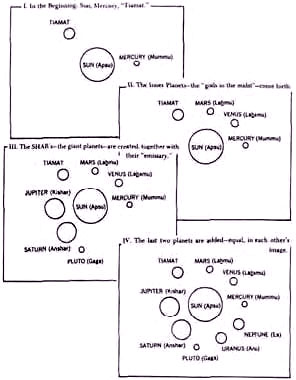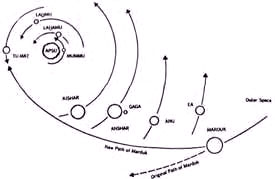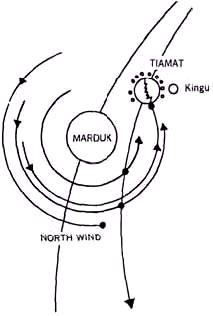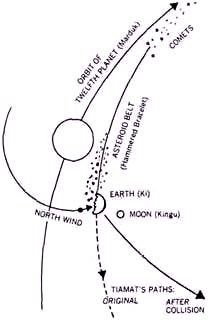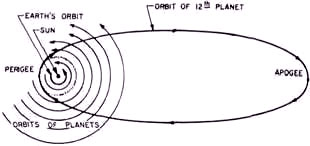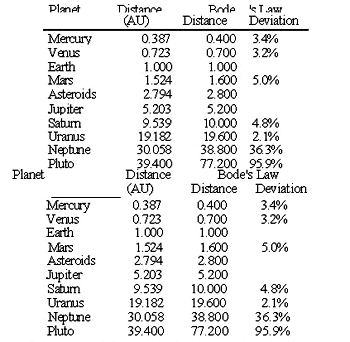|
2 - IT CAME FROM OUTER SPACE
The Sumerians made clear, 6,000 years earlier, the very same fact.
Central to their cosmogony, world view, and religion was a cataclysmic event that they called the Celestial Battle. It was an event to which references were made in miscellaneous Sumerian texts, hymns, and proverbs - just as we find in the Bible's books of Psalms, Proverbs, Job, and various others. But the Sumerians also described the event in detail, step by step, in a long text that required seven tablets.
Of its Sumerian original only fragments and quotations have been found; the mostly complete text has reached us in the Akkadian language, the language of the Assyrians and Babylonians who followed the Sumerians in Mesopotamia.
The text deals with the formation of the Solar System prior to the Celestial Battle and even more so with the nature, causes, and results of that awesome collision. And, with a single cosmogonic premise, it explains puzzles that still baffle our astronomers and astrophysicists. Even more important, whenever these modern scientists have come upon a satisfactory answer - it fits and corroborates the Sumerian one!
But these examples of cosmic debris, it has been assumed, go back to the very beginning of the Solar System, some 4.5 billion years ago, and are pieces of planetary matter that failed to be incorporated into the planets or their moons and rings. A little more baffling has been the asteroid belt, a band of rocks that forms an orbiting chain between Mars and Jupiter.
According to Bode's law, an empirical rule that explains why the planets formed where they did, there should have been a planet, at least twice the size of Earth, between Mars and Jupiter. Is the orbiting debris of the asteroid belt the remains of such a planet?
But was it formed that way from the very beginning, or did some external force - a forceful collision or encounter with another major celestial body - bring about the tilting?
The fact that these moons swirl around the equator of Uranus in its tilted position - forming, all together, a kind of bull's-eye facing the Sun (Fig. 7) - made scientists wonder whether these moons were there at the time of the tilting event, or whether they formed after the event, perhaps from matter thrown out by the force of the collision that tilted Uranus.
Figure 7
The theoretical basis for the answer was enunciated, prior to the encounter with Uranus, among others by Dr. Christian Veillet of the French Centre d'Etudes et des Recherches Geodynamiques. If the moons formed at the same time as Uranus, the celestial "raw material" from which they agglomerated should have condensed the heavier matter nearer the planet; there should be more of heavier, rocky material and thinner ice coats on the inner moons and a lighter combination of materials (more water ice, less rocks) on the outer moons.
By the same principle of the distribution of material in the Solar System - a larger proportion of heavier matter nearer the Sun, more of the lighter matter (in a "gaseous" state) farther out - the moons of the more distant Uranus should be proportionately lighter than those of the nearer Saturn.
Likewise, the Voyager 2 data showed - again contrary to what "should have been" - that the two larger inner moons of Uranus, Ariel and Umbriel, are lighter in composition (thick, icy layers; small, rocky cores) than the outer moons Titania and Oberon, which were discovered to be made mostly of heavy rocky material and had only thin coats of ice.
These dark rings, warped, tilted, and "bizarrely elliptical," were quite unlike the symmetrical bracelets of icy particles circling Saturn. Pitch-black also were six of the new moonlets discovered at Uranus, some acting as "shepherds" for the rings.
The obvious conclusion was that the rings and moonlets were formed from the debris of a "violent event in Uranus's past." Assistant project scientist at JPL Ellis Miner stated it in simpler words:
The theory of a catastrophic celestial collision as the event that could explain all the odd phenomena on Uranus and its moons and rings was further strengthened by the discovery that the boulder-size black debris that forms the Uranus rings circles the planet once every eight hours - a speed that is twice the speed of the planet's own revolution around its axis. This raises the question, how was this much-higher speed imparted to the debris in the rings?
In simpler words, it means that in all probability the moons in question were created as a result of the collision that knocked Uranus on its side. In press conferences the NASA scientists were more audacious.
Astronomer Garry Hunt of the Imperial College, London, summed it up in seven words:
But neither in the verbal briefings nor in the long written reports was an attempt made to suggest what the "something" was, where it had come from, and how it happened to collide with, or bang into, Uranus.
Nereid, although of a size that by planetary-formation rules should be spherical, has an odd shape like that of a twisted doughnut. It also is bright on one side and pitch-black on the other.
All these peculiarities have led Martha W. Schaefer and Bradley E. Schaefer, in a major study on the subject published in Nature magazine (June 2, 1987) to conclude that,
The dark material that shows up on one side of Nereid could be explained in one of two ways - but both require a collision in the scenario.
Either an impact on one side of the satellite swept off an existing darker layer there, uncovering lighter material below the surface, or the dark matter belonged to the impacting body and "went splat on one side of Nereid."
That the latter possibility is the more plausible is suggested by the discovery, announced by the JPL team on August 29, 1989, that all the new satellites (six more) found by Voyager 2 at Neptune "are very dark" and "all have irregular shapes," even the moon designated 1989N1, whose size normally would have made it spherical.
In this scenario the original small Neptune satellite "would have been devoured by Triton," but the force of the collision would have been such that it dissipated enough of Triton's orbital energy to slow it down and be captured by Neptune's gravity.
Another theory, according to which Triton was an original satellite of Neptune, was shown by this study to be faulty and unable to withstand critical analysis.
The data collected by Voyager 2 from the actual flyby of Triton supported this theoretical conclusion. It also was in accord with other studies (as by David Stevenson of Caltech) that showed that Triton's internal heat and surface features could be explained only in terms of a collision in which Triton was captured into orbit around Neptune.
But the question was left without an answer. Unanswered too was the question of whether the cataclysms at Uranus and Neptune were aspects of a single event or were unconnected incidents.
The Sumerian texts speak of a single but comprehensive event. Their texts explain more than what modern astronomers have been trying to explain regarding the outer planets.
The ancient texts also explain matters closer to home, such as the origin of the Earth and its Moon, of the Asteroid Belt and the comets. The texts then go on to relate a tale that combines the credo of the Creationists with the theory of Evolution, a tale that offers a more successful explanation than either modern conception of what happened on Earth and how Man and his civilization came about.
The Sun (APSU in the Sumerian texts, meaning "One Who Exists from the Beginning"), its little companion MUM. MU ("One Who Was Born," our Mercury) and farther away TI.AMAT ("Maiden of Life") were the first members of the Solar System; it gradually expanded by the "birth" of three planetary pairs, the planets we call Venus and Mars between Mummu and Tiamat, the giant pair Jupiter and Saturn (to use their modern names) beyond Tiamat, and Uranus and Neptune farther out (Fig. 8).
Fig. 8
Into this original Solar System, still unstable soon after its formation (I estimated the time about four billion years ago), an Invader appeared.
The Sumerians called it NIBIRU; the Babylonians renamed it Marduk in honor of their national god. It appeared from outer space, from "the Deep," in the words of the ancient text.
But as it approached the outer planets of our Solar System, it began to be drawn into it. As expected, the first outer planet to attract Nibiru with its gravitational pull was Neptune - E.A ("He Whose House Is Water") in Sumerian. "He who begot him was Ea," the ancient text explained.
Sparks and flashes bolted from it to Neptune and Uranus as it passed near them. It might have arrived with its own satellites already orbiting it, or it might have acquired some as a result of the gravitational pull of the outer planets. The ancient text speaks of its "perfect members. . .difficult to perceive" - "four were his eyes, four were his ears."
Figure 9
At the same time we learn from a later passage in the ancient text that Nibiru/Marduk himself gained three satellites as a result of this encounter.
Although the Sumerian texts describe how, after its eventual capture into solar orbit, Nibiru/Marduk revisited the outer planets and eventually shaped them into the system as we know it today, the very first encounter already explains the various puzzles that modern astronomy faced or still faces regarding Neptune, Uranus, their moons, and their rings.
Past Neptune and Uranus, Nibiru/Marduk was drawn even more into the midst of the planetary system as it reached the immense gravitational pulls of Saturn (AN.SHAR, "Foremost of the Heavens") and Jupiter (KI.SHAR, "Foremost of the Firm Lands").
As Nibiru/Marduk "approached and stood as though in combat" near Anshar/Saturn, the two planets "kissed their lips." It was then that the "destiny," the orbital path, of Nibiru/Marduk was changed forever. It was also then that the chief satellite of Saturn, GA.GA (the eventual Pluto), was pulled away in the direction of Mars and Venus - a direction possible only by the retrograde force of Nibiru/Marduk.
Making a vast elliptical orbit, Gaga eventually returned to the outermost reaches of the Solar System.
There it "addressed" Neptune and Uranus as it passed their orbits on the swing back. It was the beginning of the process by which Gaga was to become our Pluto, with its inclined and peculiar orbit that sometimes takes it between Neptune and Uranus. The new "destiny," or orbital path, of Nibiru/Marduk was now irrevocably set toward the olden planet Tiamat.
At that time, relatively early in the formation of the Solar System, it was marked by instability, especially (we learn from the text) in the region of Tiamat. While other planets nearby were still wobbling in their orbits, Tiamat was pulled in many directions by the two giants beyond her and the two smaller planets between her and the Sun.
One result was the tearing off her, or the gathering around her, of a "host" of satellites "furious with rage," in the poetic language of the text (named by scholars the Epic of Creation). These satellites, "roaring monsters," were "clothed with terror" and "crowned with halos," swirling furiously about and orbiting as though they were "celestial gods" - planets.
It was called in Sumerian KIN.GU - "Great Emissary." Now the text raised the curtain on the unfolding drama; I have recounted it, step by step, in The 12th Planet.
As in a Greek tragedy, the ensuing "celestial battle" was unavoidable as gravitational and magnetic forces came inexorably into play, leading to the collision between the oncoming Nibiru/Marduk with its seven satellites ("winds" in the ancient text) and Tiamat and its "host" of eleven satellites headed by Kingu.
Figure 10
Although they were headed on a collision course, Tiamat orbiting counterclockwise and Nibiru/Marduk clockwise, the two planets did not collide - a fact of cardinal astronomical importance. It was the satellites, or "winds," (literal Sumerian meaning: "Those that are by the side") of Nibiru/Marduk that smashed into Tiatnat and collided with her satellites.
He was wrapped with awesome terror as with a cloak.
As the two planets and their hosts of satellites came close enough for Nibiru/Marduk to "scan the inside of Tiamat" and "perceive the scheme of Kingu," Nibiru/ Marduk attacked Tiamat with his "net" (magnetic field?) to "enfold her," shooting at the old planet immense bolts of electricity ("divine lightnings"). Tiamat "was filled with brilliance" - slowing down, heating up, "becoming distended."
Wide gaps opened in its crust, perhaps emitting steam and volcanic matter. Into one widening fissure Nibiru/Marduk thrust one of its main satellites, the one called "Evil Wind." It tore Tiamat's "belly, cut through her insides, splitting her heart."
As to Kingu, Tiamat's principal satellite, the text informs us that in that first phase of the celestial collision Kingu was just deprived of its almost-independent orbit. Nibiru/Marduk took away from him his "destiny."
Nibiru/ Marduk made Kingu into a DUG.GA.E, "a mass of lifeIt Came from Outer Space 35 less clay," devoid of atmosphere, waters and radioactive matter and shrunken in size; and "with fetters bound him," to remain in orbit around the battered Tiamal. Having vanquished Tiamat, Nibiru/Marduk sailed on on his new "destiny."
The Sumerian text leaves no doubt that the erstwhile invader orbited the Sun:
Then, as a mussel, he split her into two parts. With this act the creation of "the heaven" reached its final stage, and the creation of Earth and its Moon began. First the new impacts broke Tiamat into two halves.
The upper part, her "skull," was struck by the Nibiru/Marduk satellite called North Wind; the blow carried it, and with it Kingu, "to places that have been unknown" - to a brand-new orbit where there had not been a planet before.
The Earth and our Moon were created (Fig. 11)!
Figure 11
This time his attention was focused on the "Dwelling of Ea" (Neptune), giving that planet and its twinlike Uranus their final makeup. Nibiru/Marduk also, according to the ancient text, provided Gaga/Pluto with its final "destiny," assigning to it "a hidden place" - a hitherto unknown part of the heavens.
It was farther out than Neptune's location; it was, we are told, "in the Deep" - far out in space. In line with its new position as the outermost planet, it was granted a new name: US.MI - "He Who Shows the Way," the first planet encountered coming into the Solar System - that is, from outer space toward the Sun.
Figure 12
Modern astronomers call these two planetary positions the perigee (the orbital point nearest the Sun) and the apogee (the farthest one) (Fig. 12). It is an orbit, as concluded from the evidence amassed in The 12th Planet, that takes 3,600 Earth-years to complete.
The three olden pairs (Venus and Mars, Jupiter and Saturn, Uranus and Neptune); the Earth and the Moon, the remains of the great Tiamat, though in a new position; the newly independent Pluto; and the planet that put it all into final shape, Nibiru/Marduk (Fig. 13).
Modern astronomy and recent discoveries uphold and corroborate this
millennia-old tale.
Using as a measure the astronomical unit (AU), which is the distance of Earth from the Sun, the formula indicates that there should be a planet between Mars and Jupiter (the asteroids are found there) and a planet beyond Saturn (Uranus was discovered).
The formula shows tolerable deviations up until one reaches Uranus but gets out of whack from Neptune on.
Bode's law, which was arrived at empirically, thus uses Earth as its arithmetic starting point. But according to the Sumerian cosmogony, at the beginning there was Tiamat between Mars and Jupiter, whereas Earth had not yet formed.
Dr. Amnon Sitchin has pointed out that if Bode's law is stripped of its arithmetical devices and only the geometric progression is retained, the formula works just as well if Earth is omitted - thus confirming Sumerian cosmogony:
|

